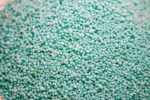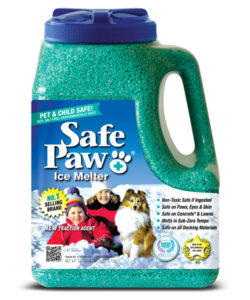The History of Safe Paw, the Pet Safe De-Icer
Safe Paws, from Gaia Enterprises, arrived in pet supply stores in 1995, the culmination of over a decade’s worth of research and testing, to offer pet-owners a safe de-icer that wouldn’t harm their pets.
Gaia means Mother Earth, and the team at Gaia works very hard to protect our Mother. In 1986, our founder Steve Greenwald originally developed Safe Thaw for an industrial client that needed a non-corrosive de-icer. At the time, there were no de-icers like that on the market, so Mr. Greenwald – a chemical engineer – spent years developing one. While industrial clients loved Safe Thaw, it was a hard sell for individual retailers.
One winter, the Greenwald family dog suffered painful sores from rock salt outside their home in New Jersey. It was a painful sight! It steeled Mr. Greenwald’s resolve to bring to the broader market a product that animals could safely walk on. Research into the dangers of common salt-based de-icers led him to further ensure that animals could also safely ingest the product.
 After years of work, Safe Paws made it into pet supply retailers like PetCo. It sold like hotcakes once word got out! Pet owners love that the tiny greenish pellets are shaped in a way that doesn’t hurt animal paws. They can also see exactly where they have spread them. Safe Paw containers have adjustable lids that spin for pouring or sprinkling the pellets with ease.
After years of work, Safe Paws made it into pet supply retailers like PetCo. It sold like hotcakes once word got out! Pet owners love that the tiny greenish pellets are shaped in a way that doesn’t hurt animal paws. They can also see exactly where they have spread them. Safe Paw containers have adjustable lids that spin for pouring or sprinkling the pellets with ease.
 Prevent Cracking of Concrete
Prevent Cracking of Concrete
Many people believe that the corrosive nature of de-icing salt is what makes the scaling and pitting, and outright holes (for instance, potholes) that appear over the winter in colder climates. Not true. If you look at concrete surfaces that have NOT been salted all winter, you will see this sort of damage as well. What de-icing does is increase the occurrences of thawing (and thus, re-freezing) in the freeze/thaw cycle. This causes more damage because the fluid is absorbed and expands when it refreezes.
Use on Concrete
No matter what product you use, be sure to shovel slush after the ice has melted to prevent water from seeping into your concrete. Concrete is porous and will absorb water. If melted snow and ice are left standing on your driveway or sidewalk, the concrete will absorb the water. Once the temperature dips, the absorbed water will freeze again, causing big problems like scaling and flaking. Newly-poured concrete less than a year old is especially susceptible to damage caused by the thaw/freeze cycle. Safe Paw should not be used on concrete that was poured less than a year prior to the use date.
How much Safe Paw should I use?
You do not need to use much Safe Paw – a little goes a long way – but spread too thin it will only make little holes in the ice here and there where it landed. Ensure an even spread of the product and then shovel up the slush made by it to prevent absorption of water into your concrete.
Use Safe Paw to prevent Ice from Forming
Put Safe Paw down as a preventative measure before snow and ice arrive to keep ice from forming a slippery sheet under the snow or treat shoveled areas with the pet safe de-icer to melt leftover ice and snow. Safe Paw can safely be used to prevent ice in temperatures below freezing for up to 72 hours.

